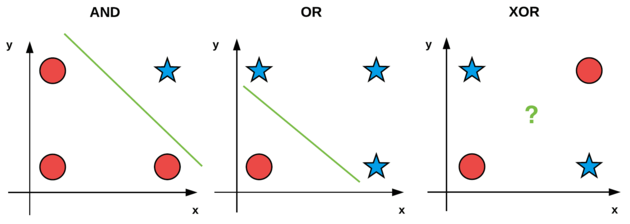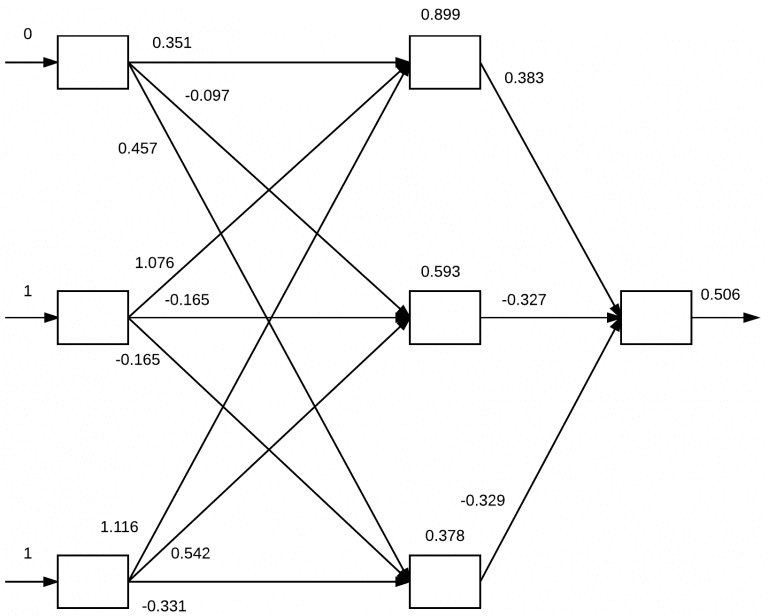Feedforward-Neural-Network-from-Scratch
n this project, we build a feedforward neural network with backpropagation from scratch using Python. Inside this repository there is Python code to build a neural network and use the back propagation algorithm to train it. Something like this is already built in to Keras / Tensorflow, but it's always good to know what is happening behind the scenes.
We use this code to train a custom neural network on both the:
- XOR Dataset
- MINST Dataset
Description
The preceptron is arguably the most simple of Artificial Neural Network (ANN) algorithms. However, a single layer Perceptron is unable separate nonlinear data. This is shown in the figure below (from Pyimagesearch):
As you can see, the AND / OR datasets can be separated via a line drawn between them. But that is impossible with the XOR dataset. So what do we do...?
Bring on the multi-layer Feedforward neural network with back propagation!
Backpropagation
The backpropagation algorithm essentially consists of two phases:
- The Forward Pass
- THe Backward Pass
The Forward Pass
This is where our inputs (raw pixel values, histograms, other pre-processed features) are passed through the network layers and predictions come from the output (aka the propagation pass). The inputs work forward through the network layers by applying a series of dot products and activations until the output layer is reached.
A visual example of the forward pass can be seen below:
The Backward Pass
This is where the gradient of the loss function at the prediction (last) layer is computed and used to recursively apply the chain rule to update the network layer weights.
Python code for the forward and backward pass can be found in the 'neuralnet.py' script.
Classification Results:
XOR Results
For this 'dataset' there are only 4 data points. Shown here:
1. [0, 0]
2. [1, 1]
3. [1, 0]
4. [0, 1]
Also with this 'dataset' we don't set aside a test set, we use the same 4 points that we used for training. This is just to prove that it is possible to separate this 'dataset'.
The output to the terminal will look similar to below (epochs = 20000, alpha = 0.5):
[INFO] epoch=1, loss=0.4993325
[INFO] epoch=100, loss=0.4731022
[INFO] epoch=200, loss=0.3174045
...
[INFO] epoch=19900, loss=0.0000004
[INFO] epoch=20000, loss=0.0000004
[INFO] data=[0 0], ground-truth=0, pred=0.0004, step=0
[INFO] data=[0 1], ground-truth=1, pred=0.9997, step=1
[INFO] data=[1 0], ground-truth=1, pred=0.9997, step=1
[INFO] data=[1 1], ground-truth=0, pred=0.0007, step=0
We can see from the above that it IS possible to classify correctly the XOR 'dataset', as long as we have one or more hidden layers.
MINST Results
For this example, we use a subset of the popular MINST dataset (which is built into the scikit-learn library). It includes ~1,800 grayscale images of digits 0-9. They are 8x8 images and when flattene they are a 64 dimension vector.
We set aside 25% of the images for testing which means we train off of the other 75%.
The output to the terminal will look similar to below (epochs = 800, alpha = 0.1):
[INFO] epoch=1, loss=586.4966039
[INFO] epoch=100, loss=0.0495874
[INFO] epoch=200, loss=0.0080397
[INFO] epoch=300, loss=0.0030552
[INFO] epoch=400, loss=0.0015725
[INFO] epoch=500, loss=0.0009475
[INFO] epoch=600, loss=0.0006291
[INFO] epoch=700, loss=0.0004462
[INFO] epoch=800, loss=0.0003319
[INFO] evaluating network...
precision recall f1-score support
0 0.98 1.00 0.99 42
1 0.94 0.96 0.95 50
2 0.97 0.97 0.97 38
3 0.97 0.97 0.97 38
4 0.93 1.00 0.96 40
5 1.00 0.93 0.97 46
6 1.00 1.00 1.00 48
7 1.00 1.00 1.00 50
8 0.98 0.89 0.93 46
9 0.94 0.98 0.96 52
accuracy 0.97 450
macro avg 0.97 0.97 0.97 450
weighted avg 0.97 0.97 0.97 450
We can see that using a feedforward neural netowrk with backpropagation that we can achieve pretty good classification results for the MINST dataset.
Getting Started
Dependencies
See requirements.txt
Installing
Clone the project:
git clone git@github.com:reedajohns/k-NN-Image-Classifier-Hot-Dog-or-Not-Hot-Dog.git
Executing program
Open terminal and run either command:
python mnist_example.py
python xor_example.py
Authors
Contributors names and contact info
Reed Johnson (https://www.linkedin.com/in/reed-a-johnson/)
Version History
- 0.1
- Initial Release
License
This project is licensed under the GNU GENERAL PUBLIC License - see the LICENSE.md file for details
Acknowledgments
Inspiration, code snippets, etc.

